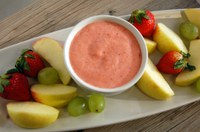Prairie Fare: Try This 10-question Summer Food Safety Quiz
(Click an image below to view a high-resolution image that can be downloaded)
By Julie Garden-Robinson, Food and Nutrition Specialist
NDSU Extension
The other day, I wiped off and arranged the outdoor furniture on our patio after the furniture finally came out of storage.
Then I sat down at the table to enjoy the warm breeze and admire the flowers I just planted. After a long, cold winter and spring, I was beginning to wonder whether warm temperatures ever would arrive.
My husband started firing up the grill. Our dogs trotted over to check out the situation. Usually, the smell of a grill means they will get a little sample of meat. They received a pat on the head, which they appreciated slightly.
I went inside to prepare the rest of the food and gather dishes and serving utensils. Summer is almost here, so some of our cooking and dining experiences are moving outdoors.
Unfortunately, each year, about one in six people in the U.S. acquires a foodborne illness, and outbreaks tend to increase during warm months. We can avoid having our fun summer dining experiences make headlines by taking some steps to food safety.
Let’s review some of the rules for summer food safety in the form of a quiz about cooking temperatures and other food safety recommendations. These are the consumer temperature rules from the U.S. Department of Agriculture, which are slightly different from the Food and Drug Administration temperatures used in restaurants. The answers are at the end.
- Before we begin preparing food, we all need to wash our hands for how many seconds?
- In the “temperature danger zone” bacteria can grow fairly quickly. What temperature range is considered the danger zone?
- You discovered that you forgot to thaw the meat for the barbecue, and your microwave oven doesn’t work. How can you thaw the meat safely?
- You just received a food thermometer. You read in an Extension publication that you should “calibrate” the thermometer, or check it for accuracy, by immersing the probe in a container of 50 percent crushed ice and 50 percent cold water. What temperature should the thermometer read when you place it in the ice-water bath?
- You bought a picnic pack of meat, including pork, beef and chicken. You are checking meat on your grill using your newly calibrated thermometer. To what internal temperature should pork chops reach?
- To what internal temperature should burgers made from ground beef reach?
- To what temperature should chicken breasts be cooked?
- The food is coming off the grill and is ready to serve on a nearby picnic table. The outdoor temperature is 90 F. How long can perishable food, such as cut vegetables and salads, safely be at this temperature? What additional steps could you take to assure food safety?
- How can you help prevent cross-contamination when you remove food from a grill?
- You grilled some extra hot dogs and burgers to chill and eat later. To what temperature should you reheat the food? How long can you keep them in your refrigerator safely?
The answers are:
- Wash your hands for at least 20 seconds using warm water and soap.
- The temperature danger zone is 40 to 140 F. Keep cold food cold (below 40 F) and hot foods hot (above 140 F).
- You can thaw meat safely by putting it in a leak-proof plastic bag and immersing it in cool water. Change the water about every 30 minutes. If you thaw meat in a microwave oven, be sure to cook it right away. Don’t put it back in the refrigerator.
- The thermometer should read 32 F, the freezing point of water. Check if you can adjust your food thermometer to be accurate; if not, you probably need a new one.
- Cook pork chops to an internal temperature of 145 F and allow a three-minute holding time. Be aware of where the thermometer’s sensor is; sometimes the sensor is at least 1 inch along the stem and sometimes the sensor is closer to the thermometer’s tip.
- Cook ground beef to an internal temperature of 160 F.
- Cook chicken and other poultry to an internal temperature of 165 F.
- When temperatures reach 90 F, food should spend no more than one hour outside of temperature control. Serve cold foods nested in a bowl of ice or in a cooler with ice. Cover the food to protect it from bugs, too.
- Be sure to bring a clean plate and clean utensils to the grill to retrieve your food.
- Reheat leftovers to 165 F, and use them within three or four days.
How did you do? If you need to brush up on food safety, check out the NDSU Extension food and nutrition website at https://www.ag.ndsu.edu/food/food-safety/at-home for details about preparing, cooking and serving food safely at home. Get some recipe ideas at https://www.ag.ndsu.edu/food, too.
Here’s a cool treat to enjoy as a dessert after a grilling party or as an appetizer while you wait patiently for the main course.
Refreshing Fruit Dip
16 oz. frozen peaches, thawed
10 oz. frozen strawberries, thawed
1/2 c. honey nonfat Greek yogurt
1 Tbsp. lemon juice
1/4 tsp. almond extract
Combine all ingredients in a food processor. Blend until smooth. Serve with fresh fruit, such as apple slices or strawberries.
Makes 20 servings. Each (1/4 cup) serving has 20 calories, 0 grams (g) fat, 0 g protein, 4 g carbohydrate, 0 g fiber and 0 milligrams sodium.
(Julie Garden-Robinson, Ph.D., R.D., L.R.D., is a North Dakota State University Extension Service food and nutrition specialist and professor in the Department of Health, Nutrition and Exercise Sciences. Follow her on Twitter @jgardenrobinson)
NDSU Agriculture Communication - May 24, 2018
| Source: | Julie Garden-Robinson, 701-231-7187, julie.garden-robinson@ndsu.edu |
|---|---|
| Editor: | Ellen Crawford, 701-231-5391, ellen.crawford@ndsu.edu |



